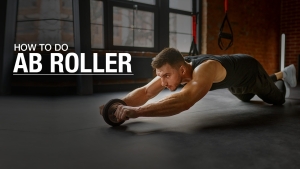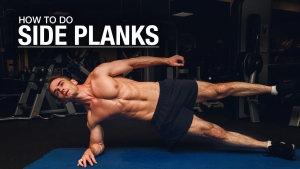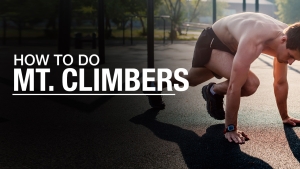
The Problem With Typical Ab Workouts
When most guys train ‘abs’ they’re probably banging out a bunch of crunches thinking they’re going to get six pack abs.
There are several issues with this approach!
First, the traditional crunch pretty much only hit the rectus abdominis muscle. In order to round out your midsection and actually get visible abs, you will need to include exercises that hit ALL the abdominal muscles including obliques, transverse abdominis and serratus.
Second, even if you’re doing several different crunch variations, most of them are just duplications of the same top-down motion. Not only does this miss several of the key movement types of the abs, but if you put too many of these too early in your ab workout, it will make it nearly impossible to perform the more difficult lower ab movements or rotational oblique exercises later on.
Creating a Perfect Abs Workout is a tall order…there really is no such thing as one ‘perfect’ core workout.
But I promise I’m not going to let you guys down with this one!
I’ve got a beginner and an advanced version of this Perfect Ab Workout for you, so that no matter your fitness level I’ve got you covered for the entire core. For equipment I’m going to include the use of just a band and a pullup bar so that even if you’re training your core at home you’ll be able to follow along.
We will include the best ab exercises to work every core muscle and function, but you’re about to see why creating the Perfect Ab Workout is less about choosing the ‘best core exercises of all time’ and more about the order you put them in!
Follow my advice and try this workout to build a stronger core and ripped sixpack abs fast!
How To Train The Abs
Why is sequence so important when it comes to ab training? It’s all about energy.
We’ve got to hit the main abdominal movement types in an order that allows us to have optimal energy for training each. If we don’t, we end up burning ourselves out before we hit some key movement types, which can create muscle imbalance down the road.
Enter my ‘Six Pack Progression’!
I’ve developed this sequence as the best order in which to train the different movement types of the abs to avoid fatigue and help you get the most out of every one of your ab exercises.
We want to start with bottom-up movements that move the legs toward the rib cage. The weight of the legs alone can be enough resistance to challenge the muscles of the abs (particularly if you are a beginner). General fatigue from your ab workout is going to make it imperative that you start here.
Next, you want to incorporate rotation into these lower ab movements (bottom-up rotation), followed by the rotationally driven oblique exercises. Finish up your routine by transitioning to movements in which the bottom and top half are moving together (midrange), and then do all top down and top down rotational exercises to target the upper abs region at the very end.
We’re going to train your abs in this exact sequence in both the beginner and advanced versions of this workout.
My ‘Six Pack Progression’ works the ab muscles in this sequence to get optimal results:
- Lower abs
- Bottom up
- Obliques
- Mid-range
- Top down rotation
- Top down
The 6 Functions Of The Abs
To make sure we’re covering all of our bases with our Perfect Ab Workout, let’s take a look at the many functions of the abs.
Abs do a whole lot more than just crunch!
WHAT ARE THE 6 FUNCTIONS OF THE ABdominal muscles?
- Spinal Flexion
- Extension Stability
- Anti-Lateral
- Anti-Rotation
- Rotational Stability
- Rotational Power
Spinal flexion is just one of many functions of the abs.

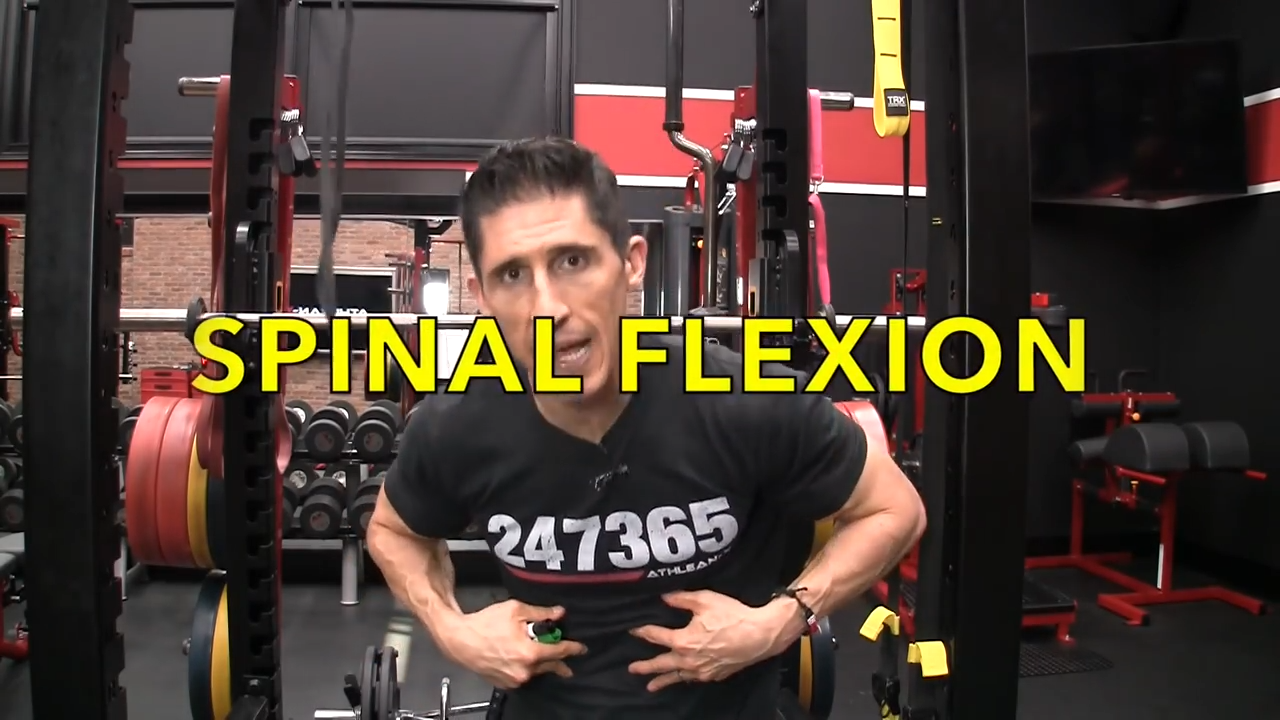
The abs also control motion in the opposite direction, pulling you back from spinal extension.

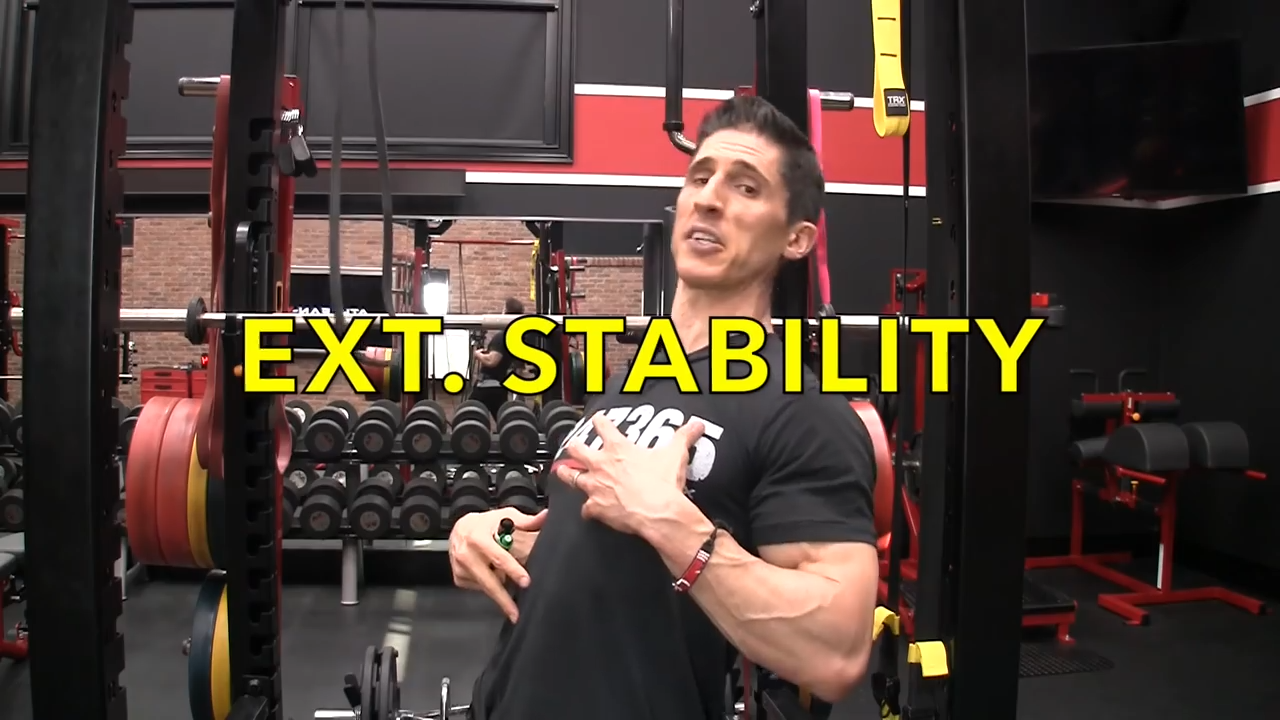
Some of the important functions of the abs are to prevent us from unnecessary or unwanted movement. One example is anti-lateral, to prevent us from lateral movement.

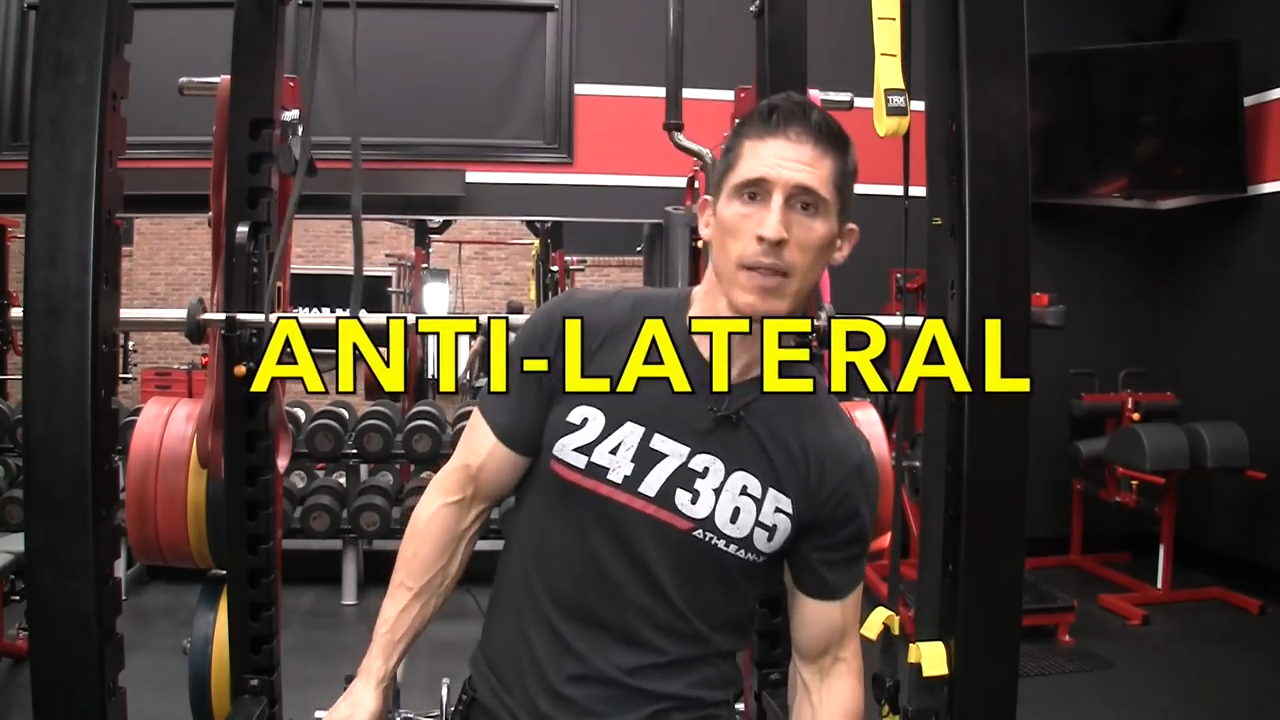
The abs will also prevent rotation, which is the function called anti-rotation.

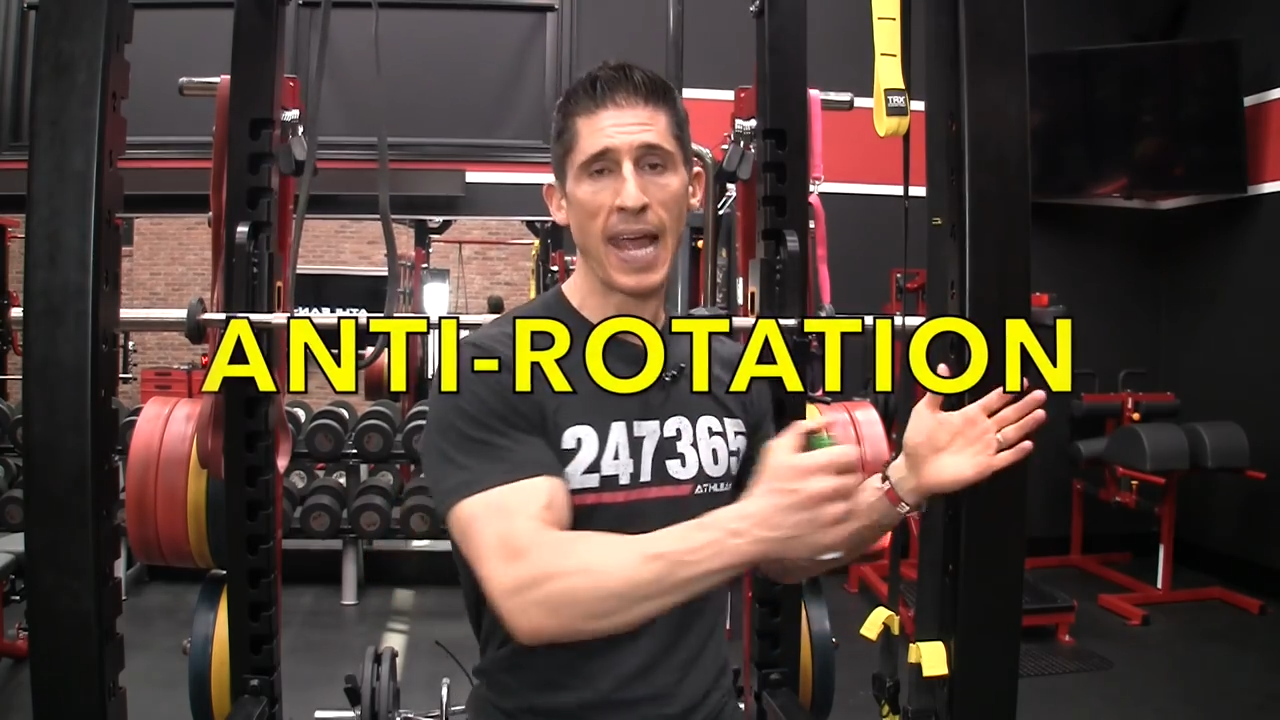
Both the abs and obliques can control rotation, giving us rotational stability.

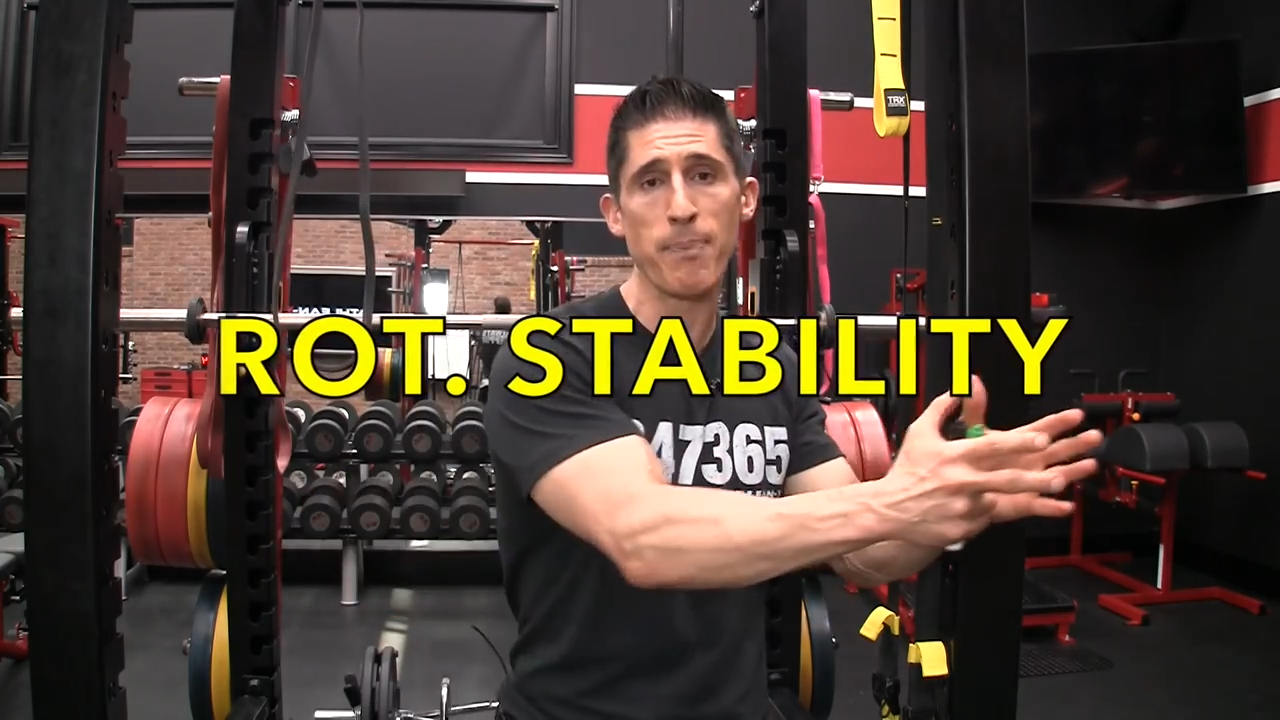
Finally the abs and obliques are both responsible for rotational power.

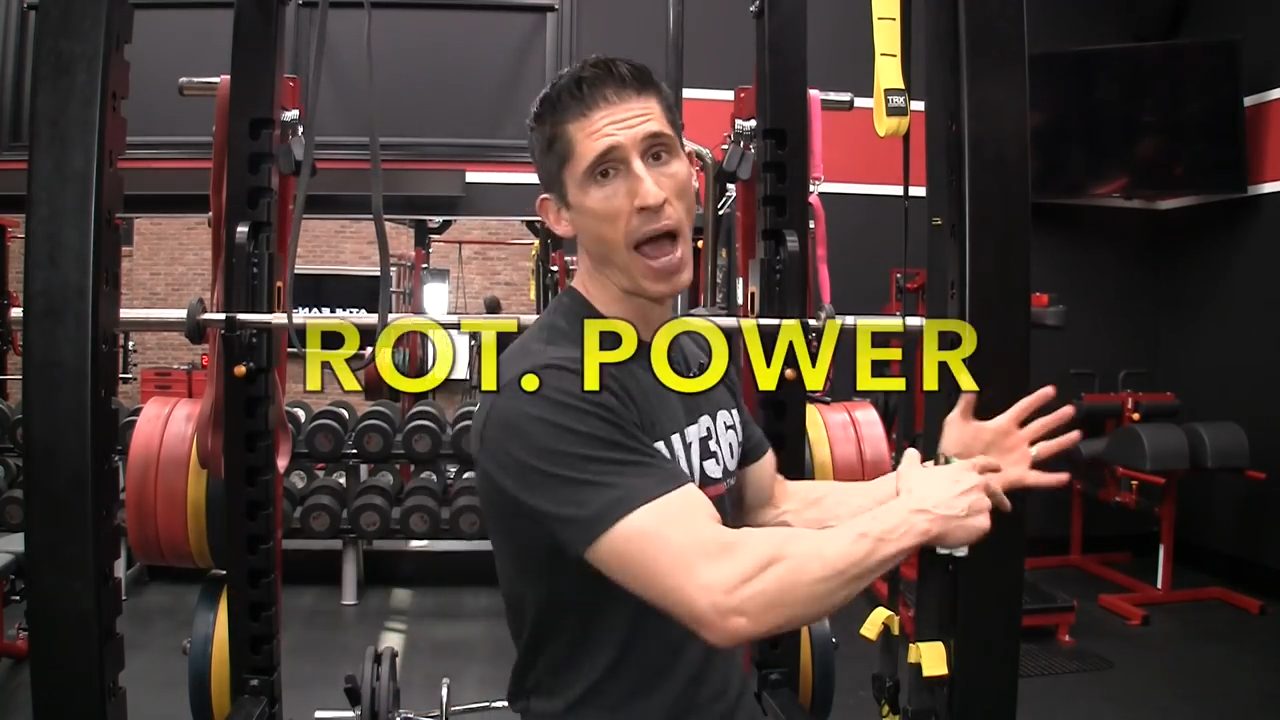
Our Perfect Ab Workout will take into account all of these functions and make sure we’re hitting them in the right sequence.
The Muscle Groups Of The Abs
Next, let’s take a closer look at the ab muscles that are going to be doing the all the hard work I’m about to throw at you.
When it comes to the anatomy part, sometimes it can be confusing. But it’s all made so much easier to understand when we break out the muscle markers!
WHAT ARE THE MUSCLES OF THE ABS?
- Rectus Abdominis
- Internal Obliques
- Transverse Abdominis
- Serratus Anterior

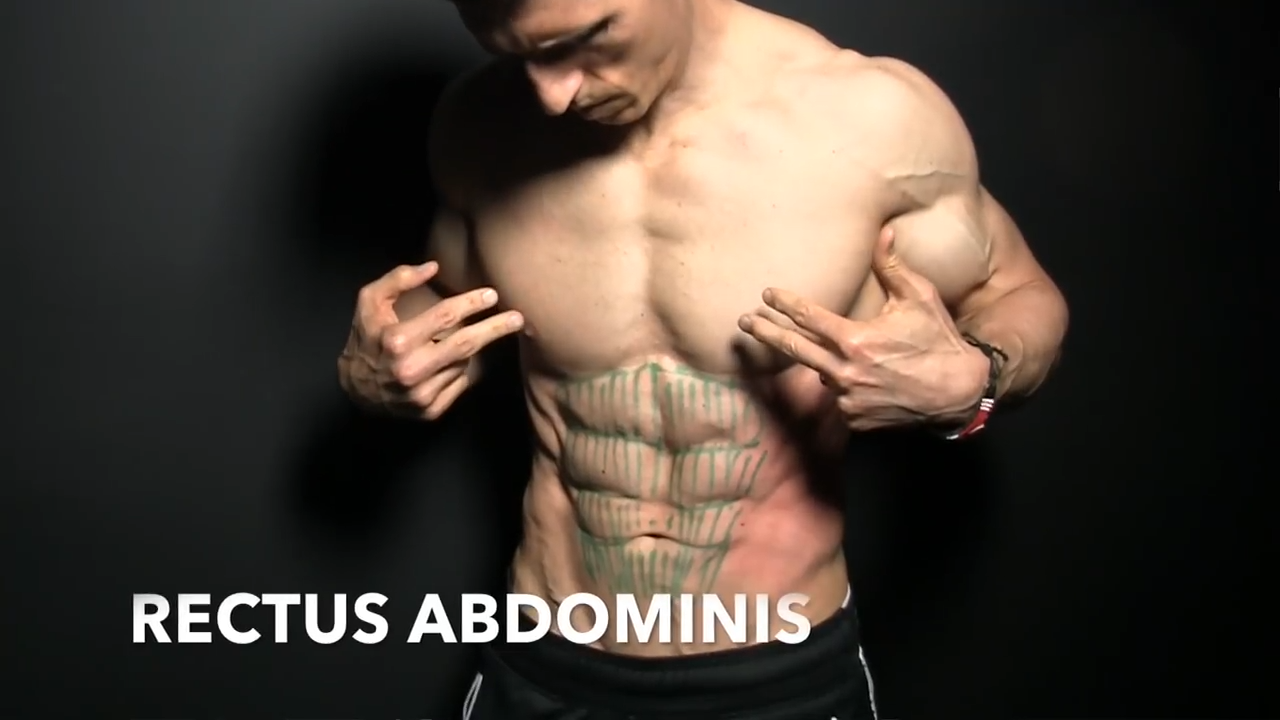
As you can see here, that ‘six-pack muscle’, the rectus abdominis, is pretty identifiable.
It’s the ab muscle everybody seems to notice, but instead of just gawking at it, let’s look at the direction of the fibers.
Where is it attaching?
It’s going up and down, north and south, attaching at the ribcage down to the pelvis. That means that it’s driving the movement of flexion of our torso, top down or bottom up.

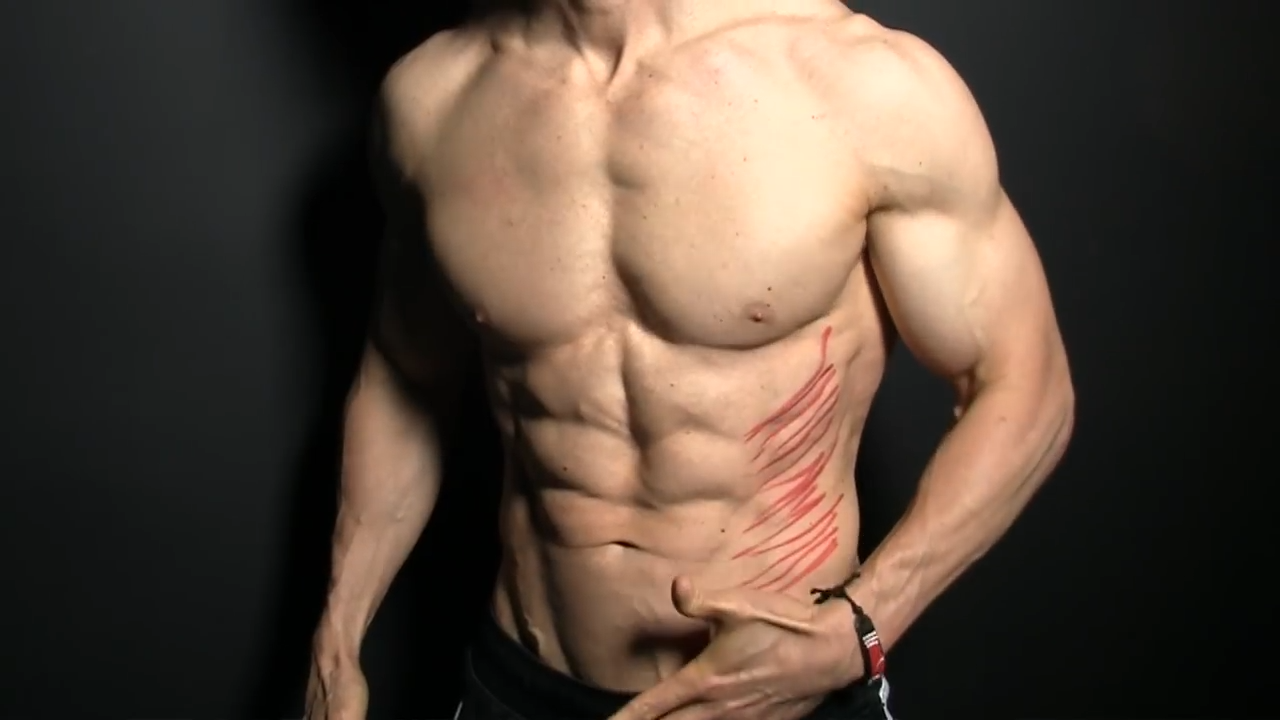
As a matter a fact, it’s at an oblique angle!
(That’s where they got the name from.)
The direction of the fibers determines the function, so the external obliques are going to be good at helping us to rotate and control rotation. When we’re choosing our exercises, we’re going to be following the fibers as we always do.

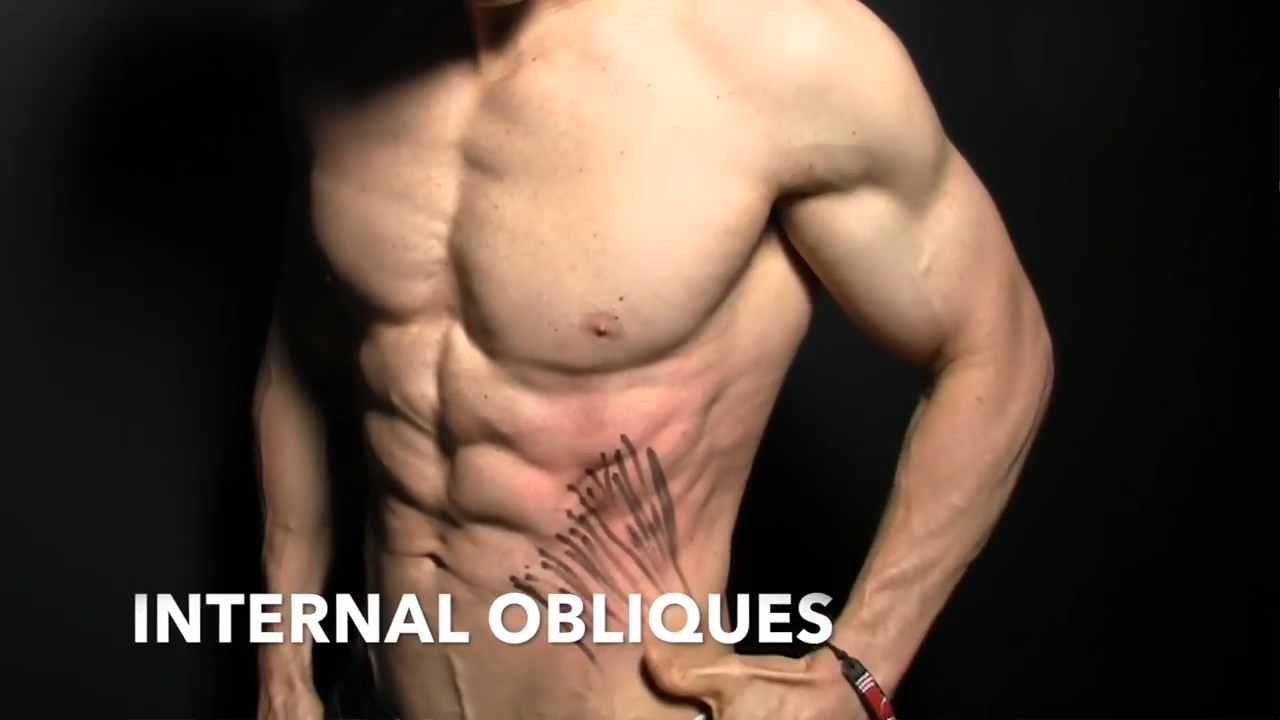
Ironically, the internal obliques run at the opposite direction from the external obliques.
The obliques on one side of the body work in concert with the obliques on the opposite side to produce some really magnificent things when it comes to rotation.

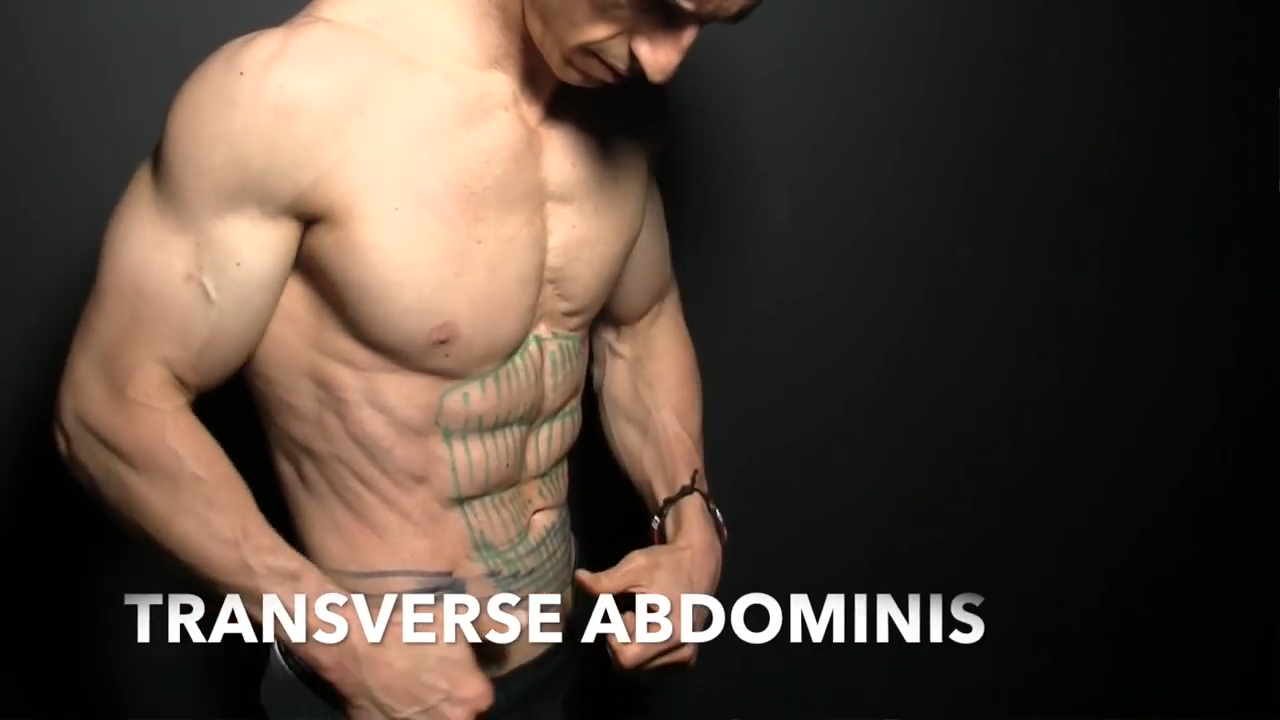
The transverse abdominis runs like a weight belt around your waist, and it helps to drive stability.

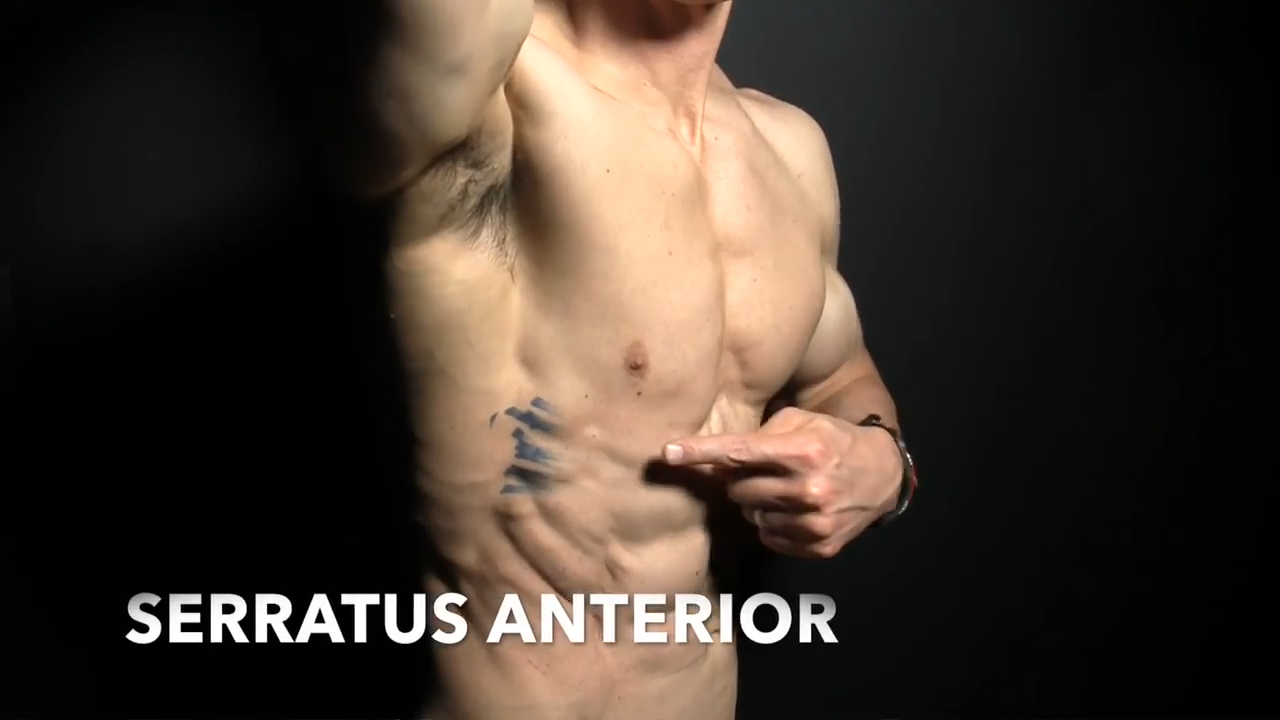
Finally on to the forgotten core muscle, the serratus.
Many people overlook just how important this core muscle is!
It has an important function in stabilizing the trunk by keeping the shoulder blades in contact with the rib cage.
The interdigitation – that’s right, I said ‘interdigitation’ – of the obliques with the serratus helps these two core muscles work together to control rotation. The obliques control the rotation of the entire torso while the serrati control the rotation of the scapula around the rib cage.
The Best Abs Workout: Step By Step
We’ll be following my ‘Six Pack Progression’ sequence as we choose each of the beginner and advanced ab exercises for each abdominal movement type.
We’re going to be hitting every single abdominal muscle and we’re going to address each function that the abs serves as well as the various movement types it is responsible for.
1.) BOTTOM UP
We’re going to kick off this Perfect Abs Workout with a bottom up movement.
We want to do bottom-up exercises for the lower abs at the point in the workout when we’ve got the most energy and ab strength. We also want to choose a single bottom-up movement instead of an entire ab workout comprised of them!
The Reverse Iso Crunch is the ideal beginner core exercise to work that bottom-up movement of the abs.
BEGINNERS: REVERSE ISO CRUNCH

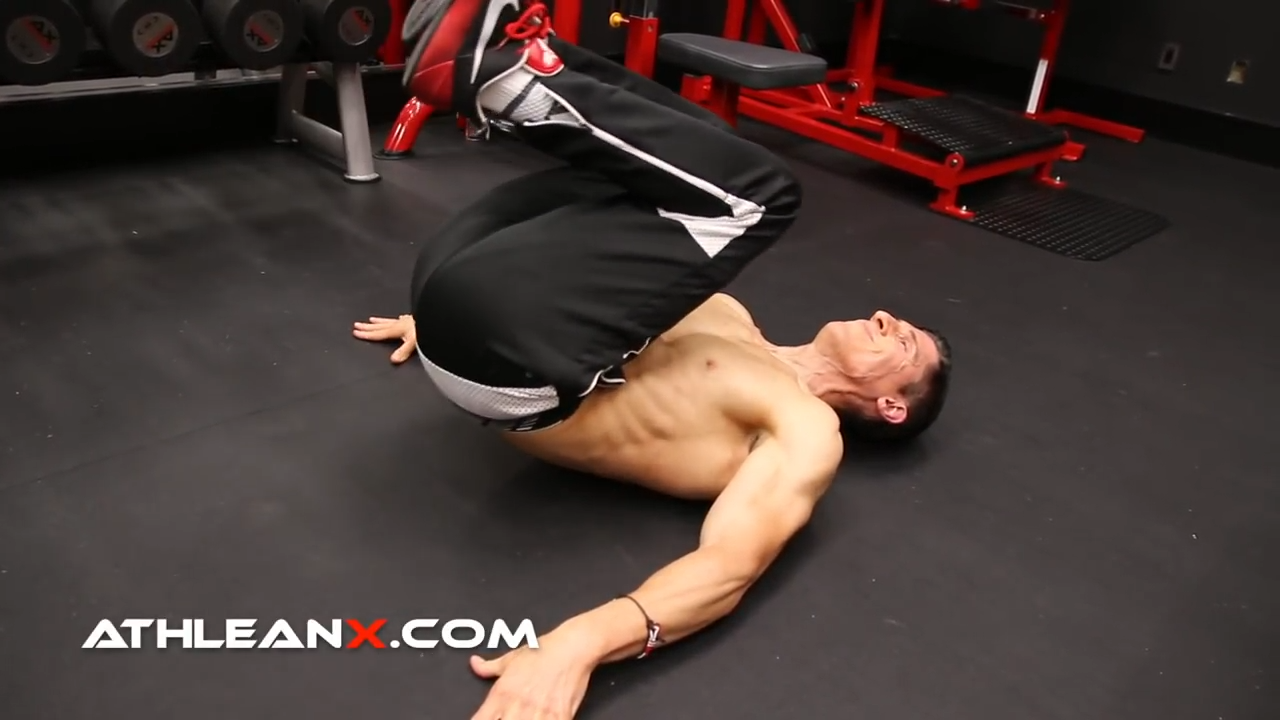
Starting position for this reverse crunch is lying face up bending your knees toward your torso. Lift your hips off the ground with a strong core and lift your legs toward your chest, and then slowly lower yourself and return to starting position.
There’s an important note on form in this abdominal exercise that we don’t want to overlook. We talked about how the rectus abdominis attaches at the ribcage and the pelvis. This means we want to move our pelvis toward the ribcage, but NOT get a swing going.
You don’t want to swing the legs down and up, down and up.
That becomes a hip flexor driven movement.
Instead we want to isolate the lifting of the pelvis, and we’ll do a better job of hitting the abs, which is what this exercise is supposed to be doing!

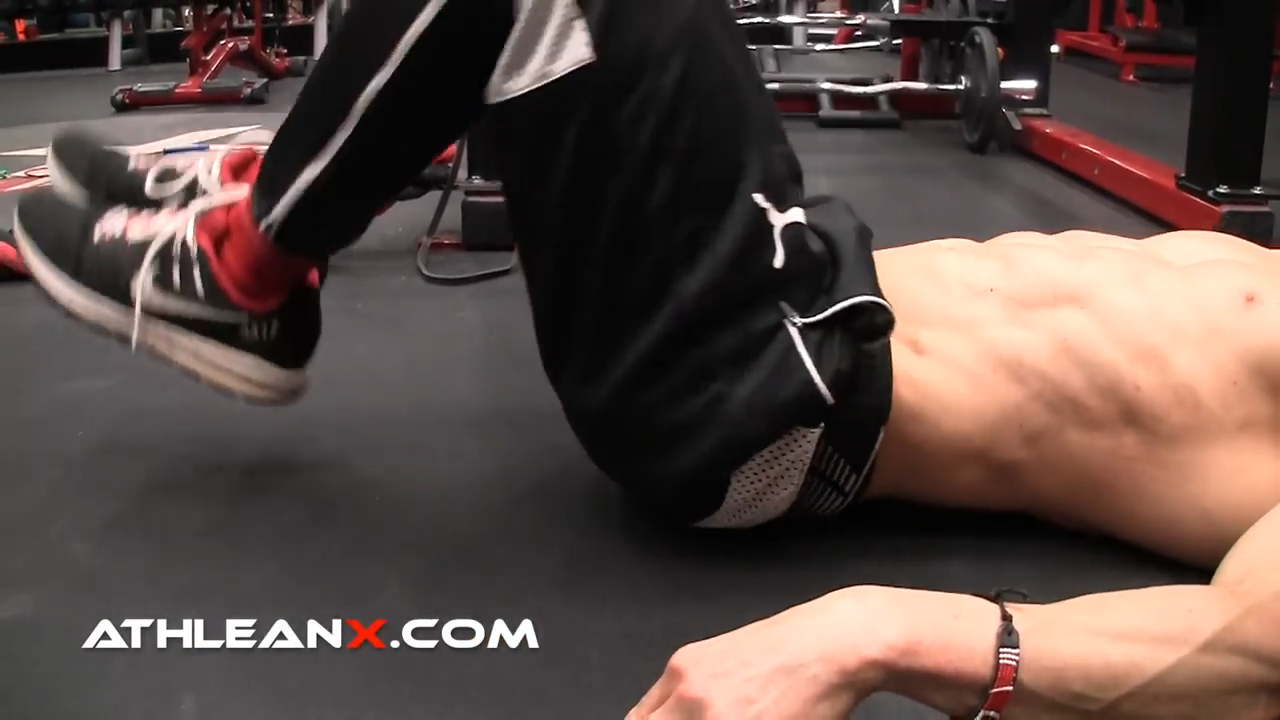
ADVANCED: HANGING X-RAISE
For our more advanced bottom-up abs exercise we’re going to be doing a Hanging X-Raise.

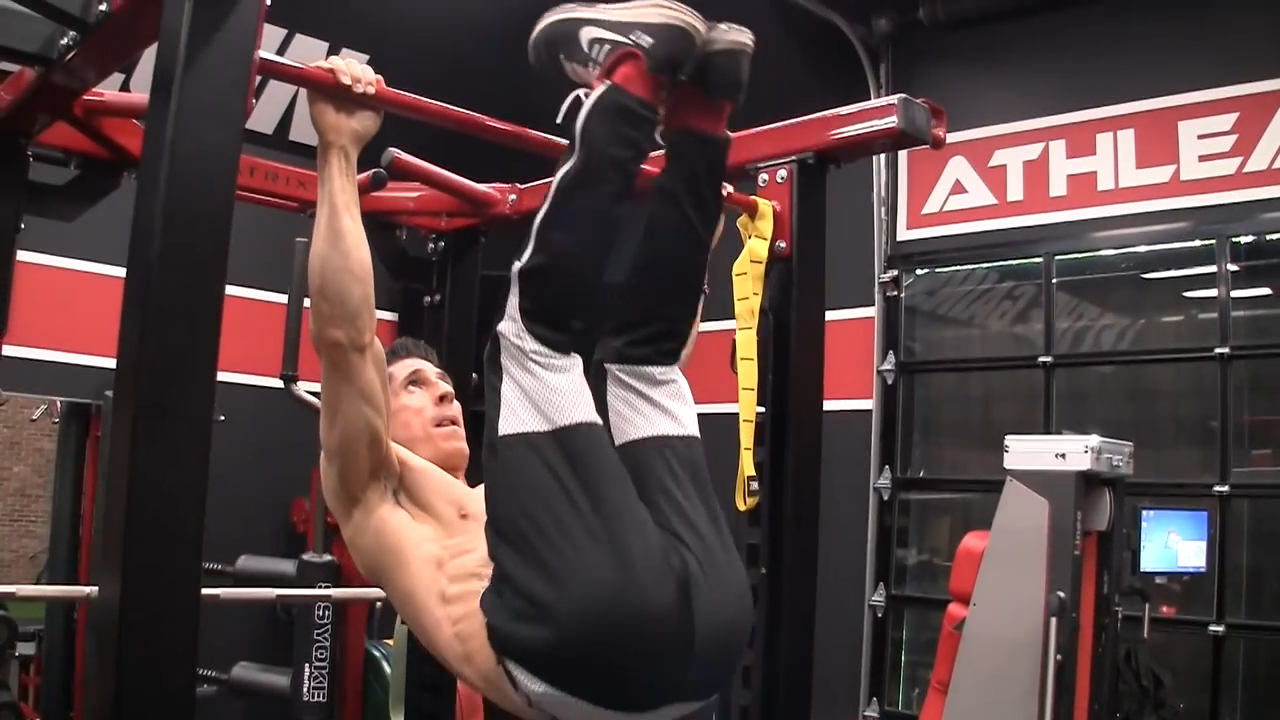
While this is similar to a hanging knee raise, it is MUCH harder. For this hanging leg raise, starting position is with legs extended straight down and out in an X position, engage your core, raise your legs straight out in front and then up toward your torso, then return to the start.
The advantage of the Hanging X-Raise is twofold.
Number one: It’s more difficult because we have to lift the weight of our legs, as opposed to having the knee bent.
Number two: We’re lifting the legs for a longer period of time than we are when we’re laying down.
The strength curve is different for these two types of leg raises. There is more prolonged tension on the hanging raise than we would be in any variation of a lying down raise.
More importantly, we have an additional accessory movement of being able to adduct the legs and stabilize the pelvis from the bottom up with the activation of the adductors.

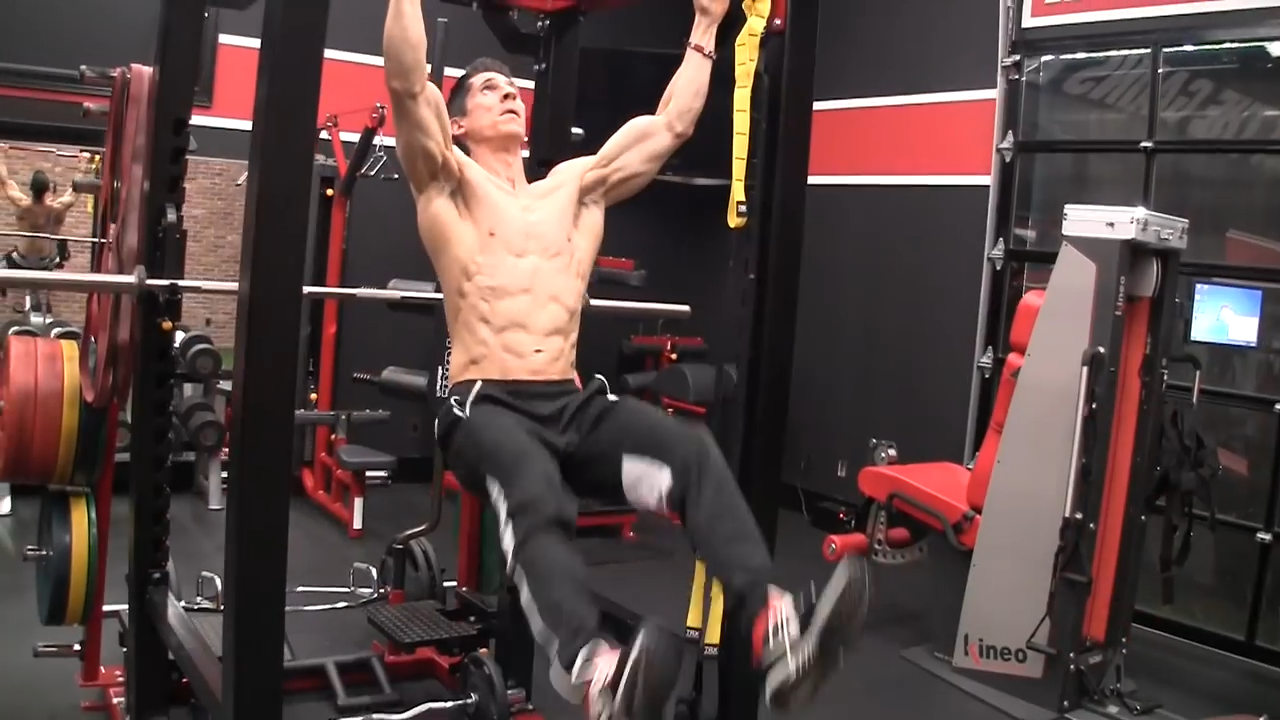
EXERCISE NOTES: Perform 30-60 seconds of the Reverse Iso Crunch for beginners or the Hanging X-Raise for advanced.
2.) BOTTOM UP ROTATION
We’re now moving onto the next movement type in the Six Pack Progression which is bottom up rotation.
Our beginner bottom up rotation exercise is a Seated Ab Circle.
BEGINNER: SEATED AB CIRCLE


Sit on the floor with arms extended at your sides and palms flat on the floor. Extend legs straight in front of you, contract your abs and begin making clockwise and counterclockwise circles with your legs.
In this exercise we get some upper body stability because we can keep our hands in contact with the ground, which is perfect for the beginners doing these workouts.
ADVANCED: HANGING LEG SPIRALS
For our advanced version of the bottom up rotation movement, we’re going to do Hanging Leg Spirals.


Hanging from a pullup bar with arms straight, lift the legs in a straight line, performing a hip twist at the end of the movement by bringing your left knee toward your right elbow, lower your legs and then switch to bring your right knee toward your left elbow.
This is similar to a knee raise, but it’s more difficult because of the extension of the legs. We’re going to add a little bit of a hip twist at the end to get that rotation.
What I want you to notice in this exercise is the rotational stability function.
We’re not trying to prevent rotation here. We’re not trying to do anything explosive with rotation either, but we are trying to control the amount of rotation we have.
EXERCISE NOTES: For beginners, perform 30-60 seconds of Seated Ab Circles alternating clockwise and counterclockwise movements, followed by 30 seconds of rest. For advanced, perform 30-60 seconds of Hanging Leg Spirals alternating left and right twists, followed by 20 seconds of rest.
3.) OBLIQUES
Sticking with the rotational theme, we’re now moving up to the obliques.
I prefer to situate the obliques at the mid-point of the workout because if you try to train them too late in your routine, you end up feeling too fatigued to do them well.
BEGINNERS: RECLINER ELBOW TO KNEE TUCK
At the beginner level, the Recliner Elbow to Knee Tuck is a great obliques exercise. When you feel how hard this hits your obliques, you’ll see that it can be more effective than bicycle crunches!

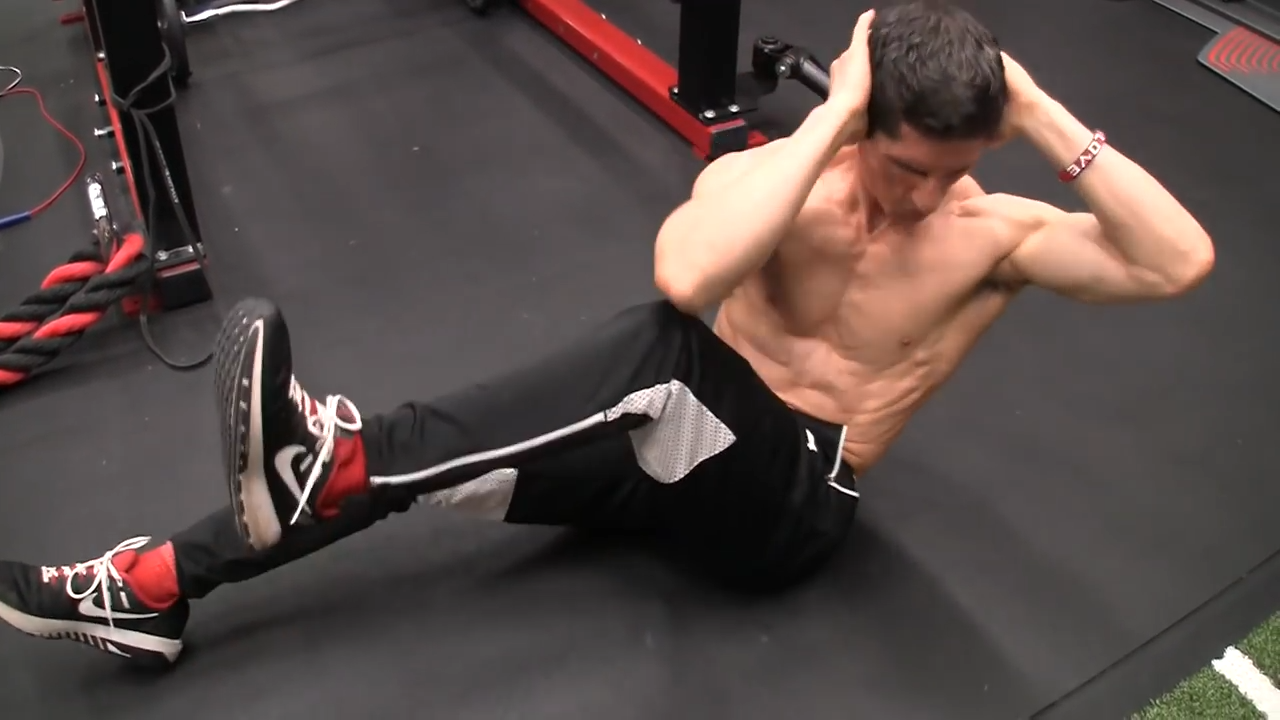
In this exercise we want to focus on function.
We’re driving rotation in this movement and we’re driving it in the direction of the fibers of the obliques.
Remember that the internal obliques and the external obliques are going to work together to drive rotation in one direction and then the opposite pair are going to drive rotation back in the other direction. Sitting in a V-Sit position with arms behind your head, rotate your right elbow toward your left leg as you bring it toward you. Then switch directions rotating your left arm toward your right leg. Make sure to maintain core engagement throughout.
ADVANCED: TORNADO CHOP
For our advanced obliques exercise we’re going to pull out the band to do a Tornado Chop.

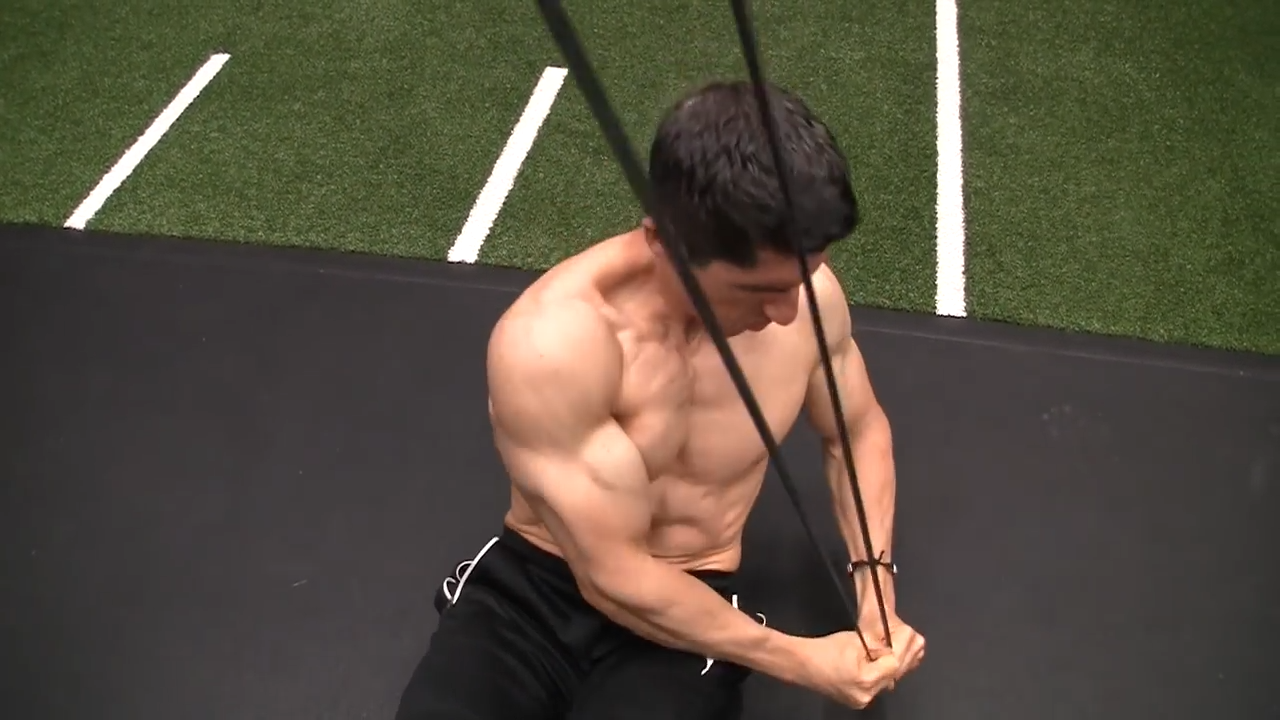
We’re using the band in this exercise to add some resistance. We’ll be driving the resistance band down into the side to create rotation. The idea is that no matter what you do for your obliques, you need to be twisting or moving left or right if you really want to hit them the hardest.
EXERCISE NOTES: For beginners, perform 30-60 seconds of the Recliner Elbow to Knee Tuck. For advanced, perform 30-60 seconds of the Tornado Chop, alternating chops toward the left and right.
4.) MIDRANGE
Now we will start to transition away from all the bottom up driven movements into some midrange movement.
We’re still involving the bottom up, but we’re combining it with some top down motion.
BEGINNERS: OPPOSITE SIDE ELBOW TO KNEE
At the beginner level we’re going to do a variation of the plank called an Opposite Side Elbow to Knee.


Here we are moving arms and legs at the same time from plank position to attack the midrange of the abs.
You guys know I’m not a huge fan of the standard plank, because it gets to be too easy very quickly. If you can hold a plank for 2, 3, 4 minutes, then you’re not doing a hard-enough version of the plank!
This version will give beginners a challenge, especially in rotational stability and extension stability.
I’m talking about that function of the abs to prevent our low back from caving in when we do lift two points of contact off the ground.
ADVANCED: SCISSOR V-UP
For those of you who are advanced, we’re going to move the top down and the bottom up, but we’re going to do them at the same time, PLUS we’ll add a little bit of a twist with this Scissor V-Up.

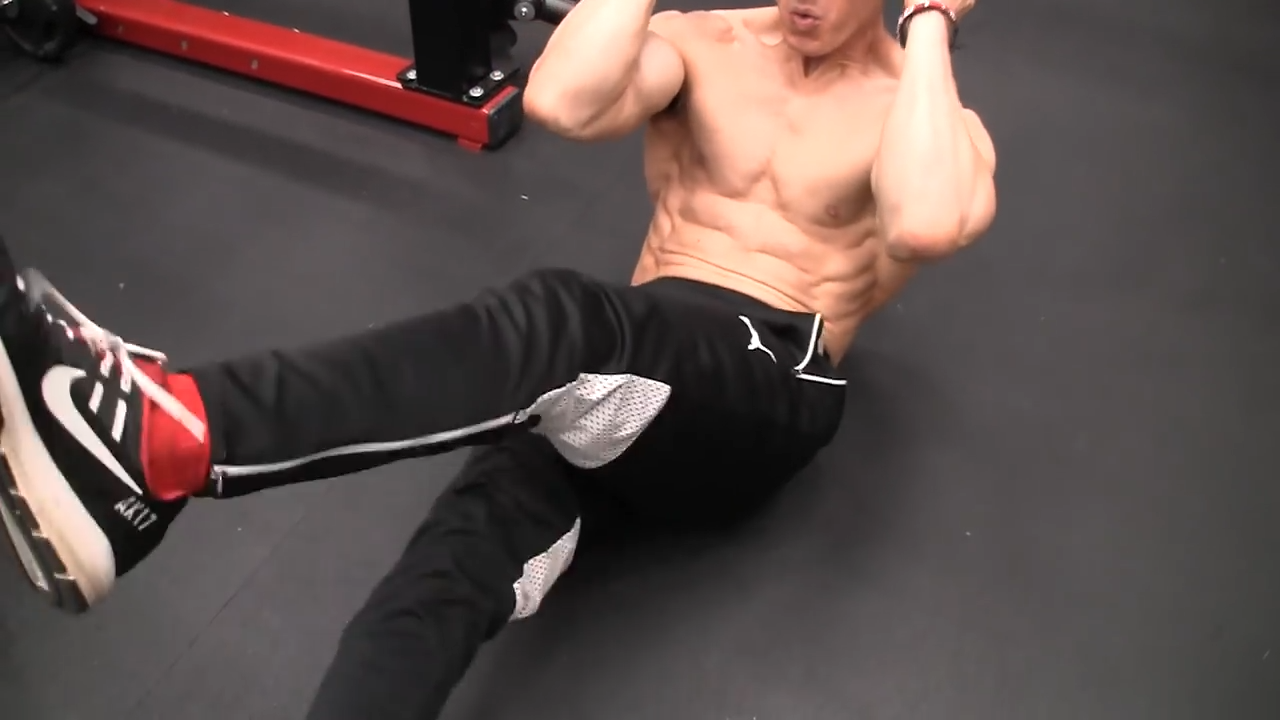
Here we are trying to keep the leg scissor going and the V-up going at the same time, incorporating upper and lower body movements simultaneously!
Raise your torso at the same time as you scissor your legs back and forth trying not to let them touch the floor.
This is a little easier than it looks because the top down motion is going to help shorten that lever arm of the legs in relation to the torso.
But don’t be fooled.
This is not easy.
Especially at this point in the workout. But, I know you can do it!
EXERCISE NOTES: For beginners, perform 30-60 seconds of Opposite Side Elbow to Knee alternating right to left, followed by 30 seconds of rest. For advanced, perform 30-60 seconds of Scissor V-Ups followed by 20 seconds of rest.
5.) TOP DOWN ROTATION
Some of my favorite ab exercises are those that challenge top down rotation because most of the time they are top down driven with our feet flat and in contact with the ground.
The Oak Tree Step out is a beginner exercise that is going to work on that anti-rotation function of the abs.
BEGINNERS: OAK TREE STEP OUT

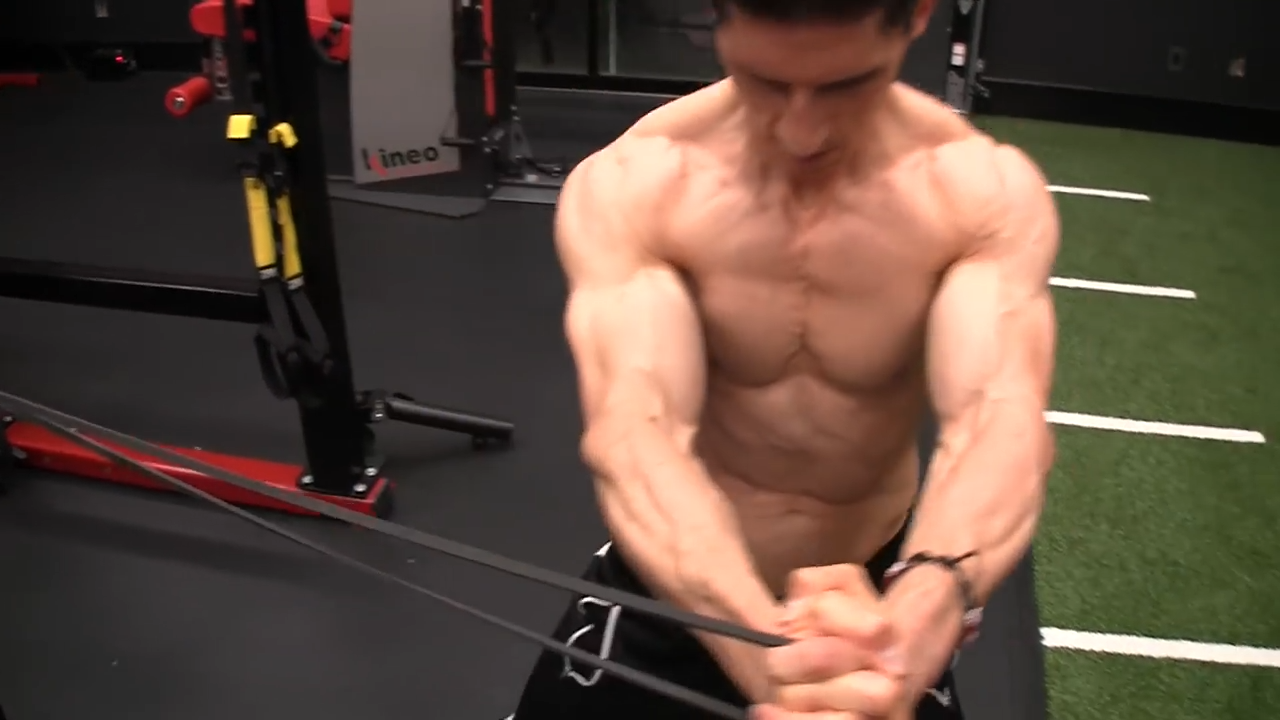
Here you want to extend the band out in front of your body as far as you can. You’re going to step out as far away as you can without letting any movement of the arms go back in the opposite direction.
If you’re strong enough and you can prevent rotation, your arms won’t budge.
If you start to see that they drift back to the anchor point every single time, then you’re not strong enough and you’ll need to lighten the resistance of the band or you need to step out a little bit less.
ADVANCED: SLEDGEHAMMER SWING
For those of you who are advanced, we’ve got a great opportunity with the Sledgehammer Swing to build some explosiveness into a rotational, ground-based movement.

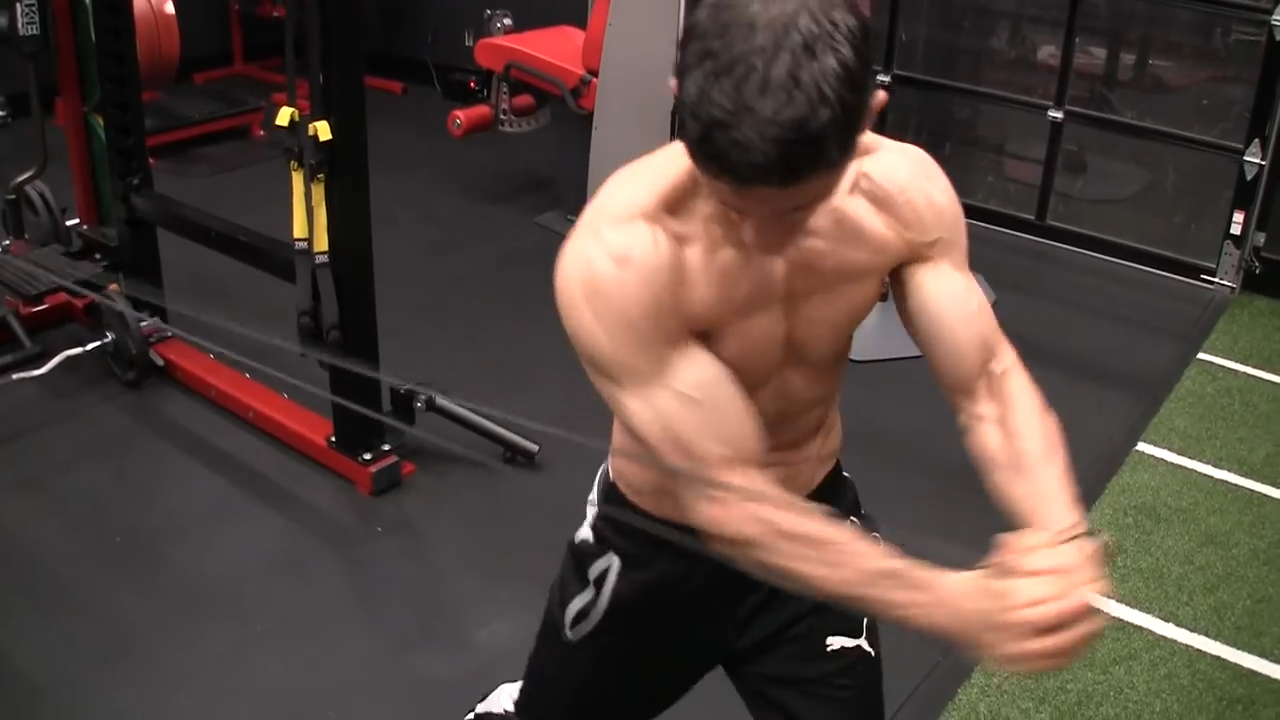
You can see that in this exercise I’m driving a lot of rotation. I’m even pivoting the foot on the ground to help me get as much power and force as I can.


EXERCISE NOTES: For beginners, perform 30-60 seconds each side of the Oak Tree Step out. For advanced, perform 30-60 seconds each side of the Sledgehammer Swing.
6.) TOP DOWN
Our top down exercises for beginner and advanced only differ in that the advanced version we’re creating more resistance with the band we’ll be using.
Before you think you have to run out and buy a different band just to train the upper abs, you don’t.
You just have to wrap it in a different way!
BEGINNERS: BANDED PULL DOWNS
If I wrap the band through itself, we have the single band that we’re going to pull down on, as you see me doing here in the beginner upper abs exercise called the Banded Pull Down.

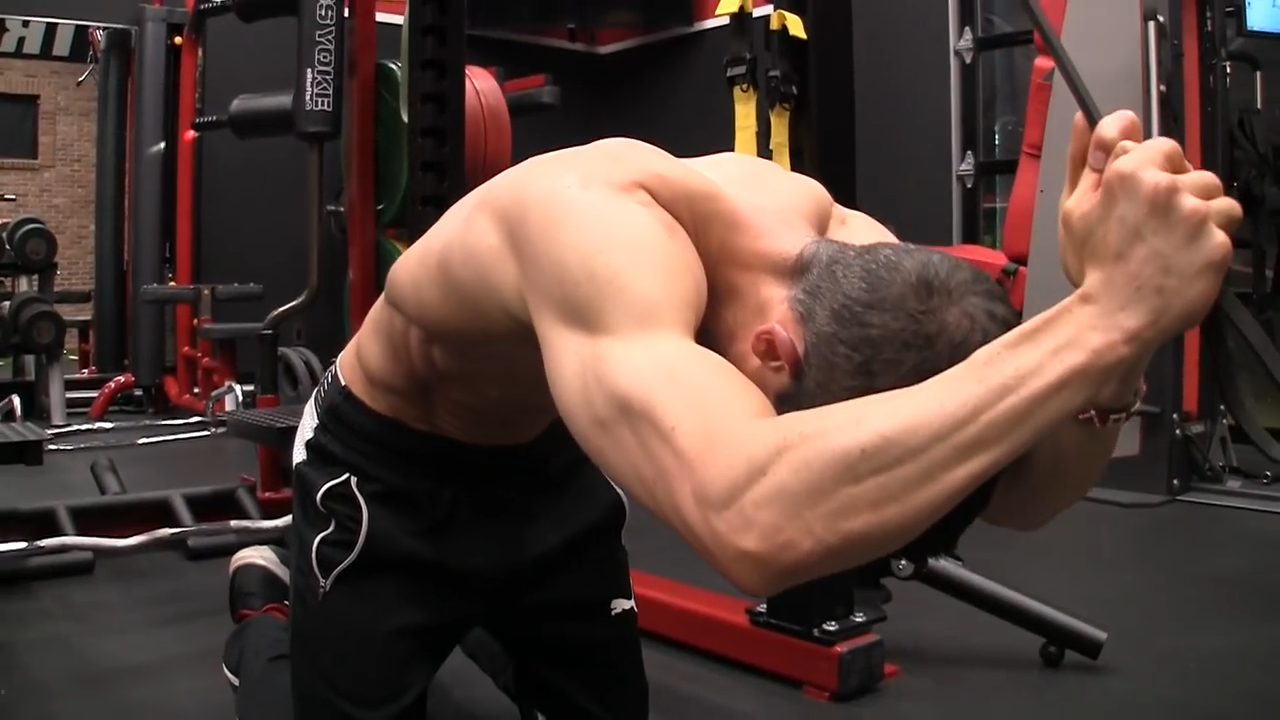
ADVANCED: BANDED PULL DOWNS (ADDITIONAL RESISTANCE)
If I want to make the pull down more a difficult exercise for the upper abdominals, all I have to do is wrap it over the bar, and then grab one portion of it in each hand, and I’ve effectively doubled the resistance by shortening the length of that band.

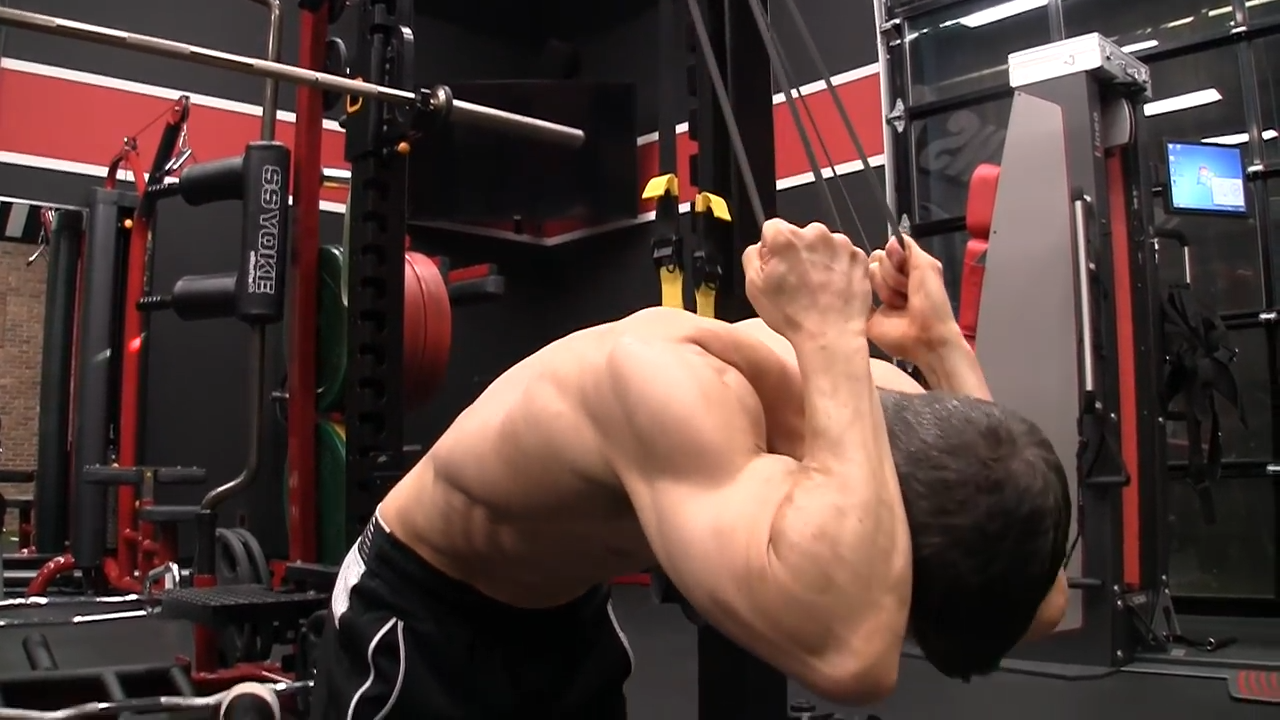
Before we move on there are two very important things I want you to focus on in these top down movements.
The first one is how we’re positioning ourselves.
You will not see me sitting back with my hip flexors!

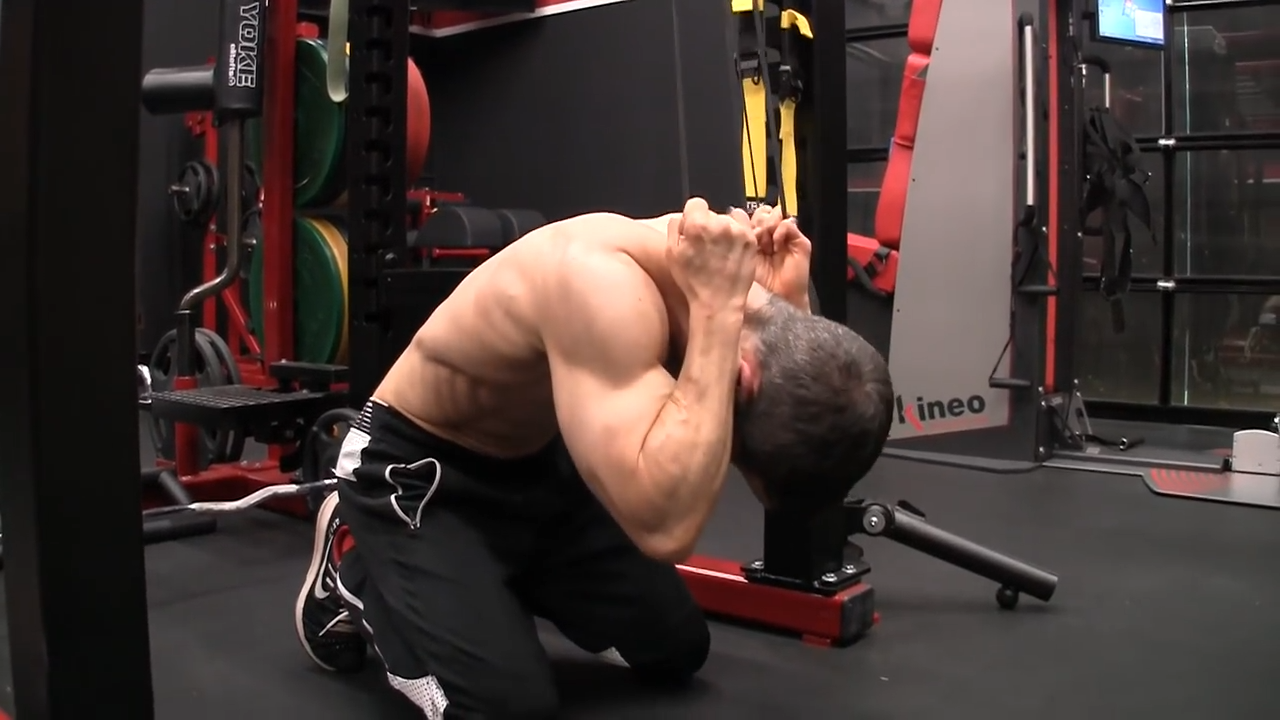
If I’m doing this exercise right, my pelvis should never go toward my heels. Sitting back there is just cheating your way through every single rep and you’re not going to get anything out of it.
Instead we want to do what the anatomy dictates, which is pulling the ribcage down and forward toward the pelvis.

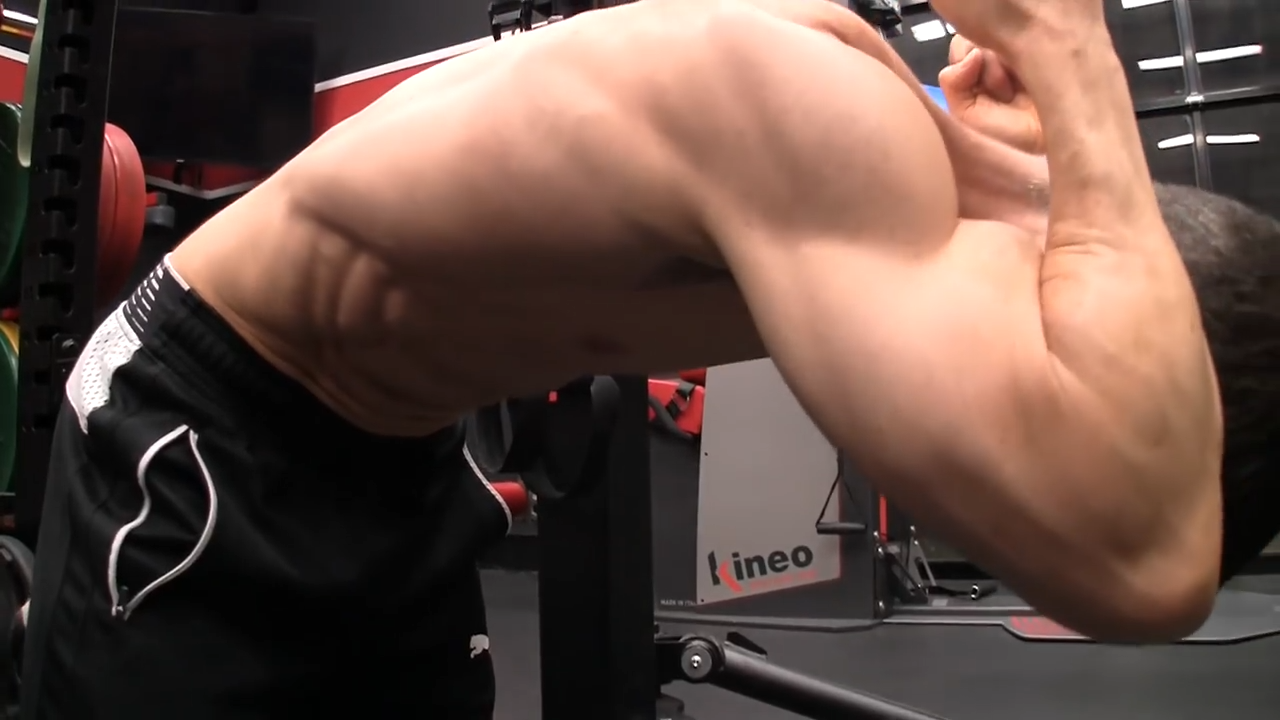
The second thing you want to focus on is what’s happening with the transverse abdominis.
This exercise gives us a great opportunity to work it.
If we can do some core bracing before our reps, we can create stability. As a matter of fact, you’ll find that you have less tendency to want to drop down into that hip flexor cheat if you do this bracing first.
To do that, you just want to flatten your stomach out using that internal weight belt to create stability.
What would it feel like if you just walked yourself into an ocean full of ice-cold water?
You’d want to pull in and flatten because of how cold it is!

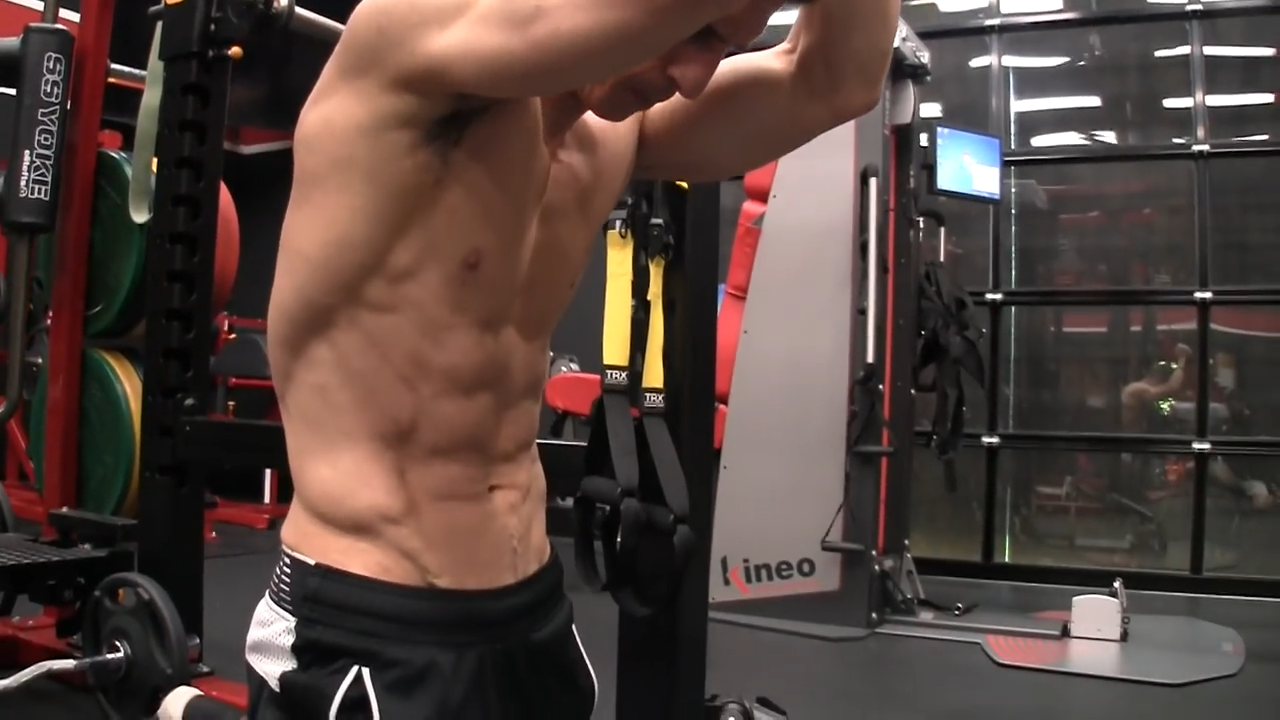
EXERCISE NOTES: For beginners, perform 30-60 seconds of Banded Pull Downs using the lighter resistance configuration of the band. For advanced, perform 30-60 seconds of Banded Pull Downs using the heavier resistance configuration of the band.
BONUS: SERRATUS!
Whereas most ab workouts would end here (or maybe even a LONG time ago) ours has one additional component.
We’ve got one more exercise.
We want to work the serratus… a completely overlooked abdominal muscle!
As I mentioned earlier, it is integrated with the obliques to control rotation of the torso.
The Plank Push Away is our beginner serratus anterior exercise.
BEGINNERS: PLANK PUSH AWAY

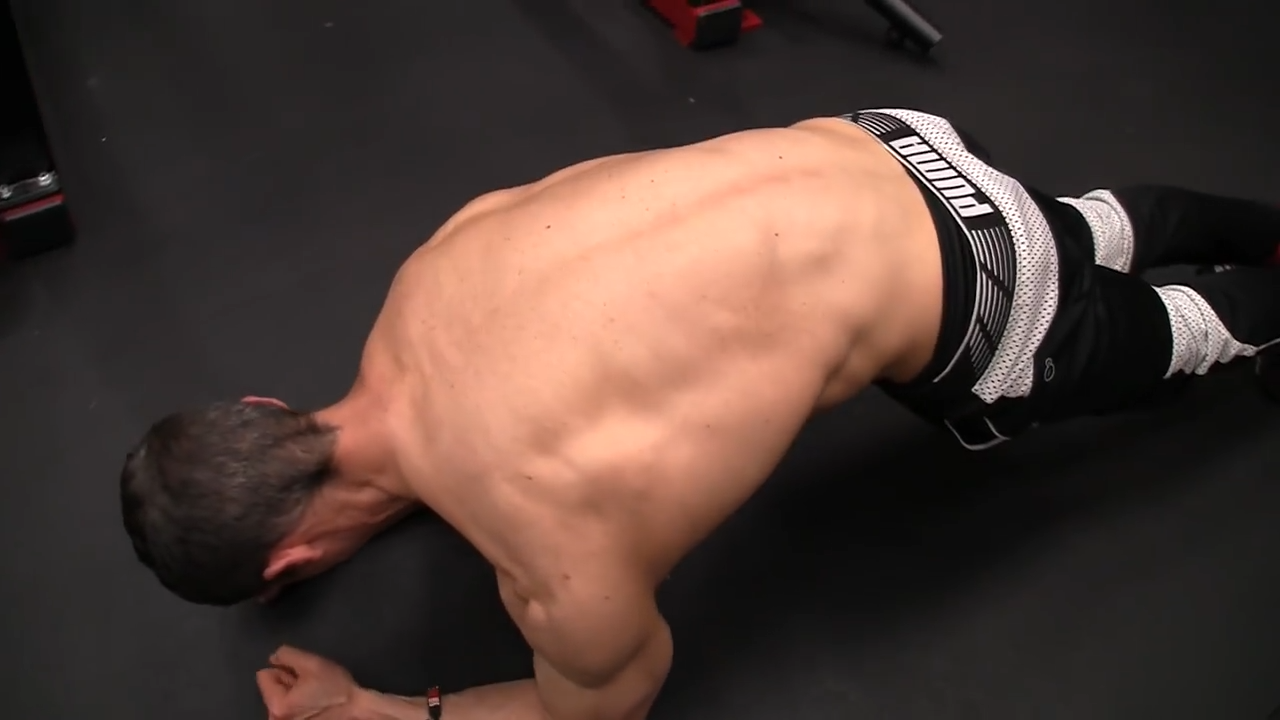
We’re going to get into the plank position, not to do a plank but instead to drive our forearms into the ground. You want to start with the shoulder blades pinched together and separate them as far as you can by pushing through the forearms into the floor.
You’ll feel this activate the serratus muscles which will create some stability of the shoulder blades as they relate to your entire ribcage.
That is a function of core stability.
ADVANCED: PLANK PUNCH OUT
Our advanced version of the serratus exercise is the Plank Punch Out.

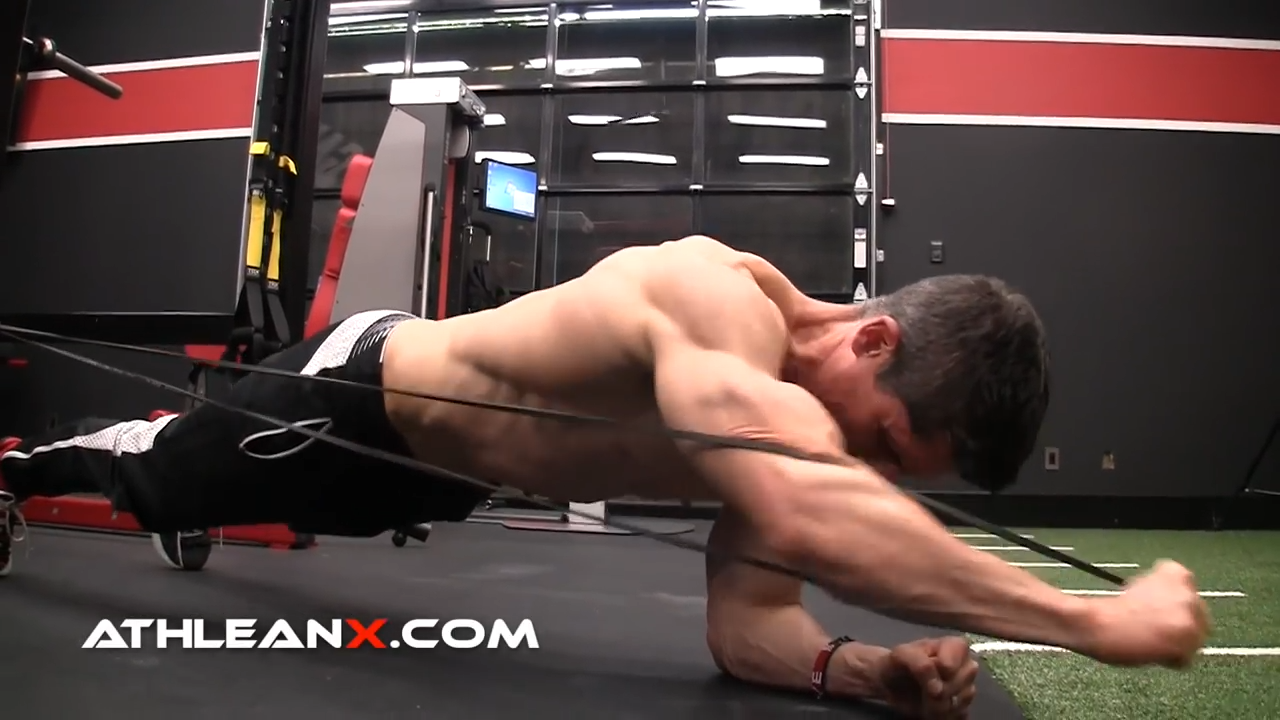
As I punch the band out and away from my body, it’s that extra push that makes the difference.
Don’t just get it out in front of you.
Push out in front, and then another 2″ or 3″.
You’ll really feel the serratus doing the work!
EXERCISE NOTES: For beginners, perform 30-60 seconds of Plank Push Aways. For advanced, perform 30-60 seconds of Plank Punch Outs.
THE WORKOUTs
So, here is the entire Perfect Abs Workout step by step, all sets, all reps for you to follow.
We’ve addressed all abdominal functions and movement types and hit ALL the abdominal muscles including the serratus.
Here are the beginner and advanced versions of this routine:
BEST ABS WORKOUT FOR BEGINNERS
- ISO REVERSE CRUNCHES: 30 – 60 SECONDS (BOTTOM UP)
- SEATED AB CIRCLES: 30 – 60 SECONDS (ALTERNATE CW/CCW DIRECTIONS) REST 30 SECONDS (BOTTOM UP ROTATION)
- RECLINER ELBOW TO KNEE TUCKS: 30 – 60 SECONDS (OBLIQUES)
- OPPOSITE SIDE ELBOW TO KNEE: 30 – 60 SECONDS (ALTERNATE RIGHT/LEFT) REST 30 SECONDS (MIDRANGE)
- OAK TREE STEPOUTS: 30 – 60 SECONDS EACH SIDE (TOP DOWN ROTATION)
- BANDED PULL DOWNS: 30 – 60 SECONDS (USE LIGHTER RESISTANCE BAND CONFIGURATION) (TOP DOWN)
- PLANK PUSH AWAYS: 30 – 60 SECONDS (SERRATUS)
BEST ABS WORKOUT FOR ADVANCED
- HANGING X-RAISES: 30 – 60 SECONDS (BOTTOM UP)
- HANGING LEG SPIRALS: 30 – 60 SECONDS (ALTERNATE RIGHT/LEFT TWISTS) REST 20 SECONDS (BOTTOM UP ROTATION)
- TORNADO CHOPS: 30 – 60 SECONDS (ALTERNATE RIGHT/LEFT CHOPS) (OBLIQUES)
- SCISSOR V-UPS: 30 – 60 SECONDS (ALTERNATE RIGHT/LEFT) REST 20 SECONDS (MIDRANGE)
- OAK TREE STEPOUTS: 30 – 60 SECONDS EACH SIDE (TOP DOWN ROTATION)
- BANDED PULL DOWNS: 30 – 60 SECONDS (USE HEAVIER RESISTANCE BAND CONFIGURATION) (TOP DOWN)
- PLANK PUNCH OUTS: 30 – 60 SECONDS (SERRATUS)
It’s important to understand there is no such thing as a ‘perfect’ workout. However, if we use science to understand why we’re doing what we’re doing for the abs and more importantly, HOW to do it effectively, you can come pretty damn close to a perfect ripped core!
If you’re looking for a complete training program that puts science into exercise selection and programming, check out our ATHLEAN-X Training Programs and get started right away on building a ripped, muscular, athletic body… and a set of ripped, visible abs!

- The problem with the way most people train abs is that they are doing too many exercises that hit just one ab muscle, the rectus abdominis. In doing so, they’re only training one abdominal movement type and are actually overtraining it.
- Another common mistake in many ab workouts is that they don’t train the abs in an effective sequence. This can cause fatigue and end up in muscle imbalance over the long run. I’ve created my Six Pack Progression to help ensure that muscles are worked in an order that allows for optimal energy in training each movement type and abdominal muscle.
- Our Perfect Ab Workout has beginner and advanced versions that work all abdominal muscles including the rectus abdominis, internal and external obliques, the transverse abdominis and the serratus anterior.
- Both versions of this workout also train all of the abdominal functions including spinal flexion, extension stability, anti-rotation, anti-lateral, and rotational stability.
BEST AB WORKOUTS FAQS
The best ab workout to improve core strength and build the abdominal and oblique muscles is a workout routine that follows the 6-pack progression, in which you work the abdominal muscle fibers in the best order that trains for all of the different abdominal movement types and to avoid fatigue. You'll do 10-15 reps of several effective ab exercises that work the abdominal muscles in this order: Lower abs, Bottom up, Obliques, Mid-range, Top down rotation, Top down.
To get a 6 pack you'll need to combine abdominal strength training with a healthy nutrition plan to reduce belly fat. Choosing effective exercises for the abs is important and it is possible to get a perfect six-pack by using body weight exercises alone, no need for heavier weight, a gym ball (Swiss ball) or cable crunches. The most effective ab workouts follow the 6-pack progression, in which you work the abs in the most optimal order of abdominal movement types, which will be more effective and help avoid fatigue.
To get strong washboard abs, men will have to go beyond simple exercises like the regular crunch and elbow plank and choose exercises for abs that are more challenging and follow the 6 pack progression, in which you work the ab muscles in the most optimal order that trains all of the ab movement types. You'll do 8-12 reps of several core-strengthening exercises that work the abs muscles in this order to avoid fatigue and strength imbalances: Lower abs, Bottom up, Obliques, Mid-range, Top down rotation, Top down. All of these can be bodyweight exercises with no extra resistance. No need for ankle weights or an exercise ball. However access to a pull-up bar may help you hit the bottom-up range of motion.
To build a 6 pack in just 22 days, you should employ a variety of exercises that follow the 6 pack progression which is an exercise program that works the abs muscles in the most effective order of abdominal movement types to avoid fatigue. There are exercise options available for beginner and advanced exercisers alike. Some of the exercises are a challenging variation of the plank variation or variation of the push-up position, while others are more effective variations of Russian twists and other ab exercises that you may be familiar with.
REFERENCES

Jeff Cavaliere M.S.P.T, CSCS
Jeff Cavaliere is a Physical Therapist, Strength Coach and creator of the ATHLEAN-X Training Programs and ATHLEAN-Rx Supplements. He has a Masters in Physical Therapy (MSPT) and has worked as Head Physical Therapist for the New York Mets, as well as training many elite professional athletes in Major League Baseball, NFL, MMA and professional wrestling. His programs produce “next level” achievements in muscle size, strength and performance for professional athletes and anyone looking to build a muscular athletic physique.
































